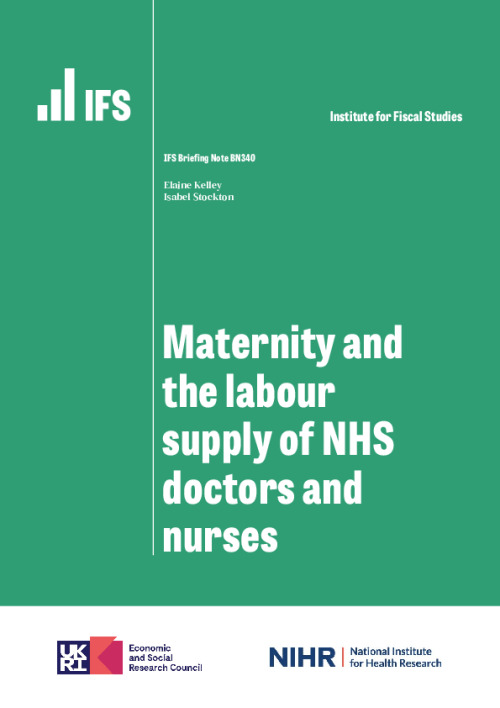More than three-quarters of all NHS employees, and 90% of registered nurses and midwives in England are women. Also, 48% of all doctors and dentists are women, and this rises to more than half for the under-50s. The majority of these women will become mothers during their careers: over the six-year period we observe, more than 17% of female nurses/midwives and doctors/dentists under the age of 50 go on maternity leave and, at any point in time, 3.7% of female doctors and dentists under the age of 50 and 3.4% of female nurses and midwives under the age of 50 are on maternity leave. The extent to which women can combine work in the NHS with motherhood has important implications for recruitment, retention and hours of work. Despite the implications of maternity and the NHS’s response to it for workforce planning, efficiency and women’s careers, there is little systematic, quantitative evidence on the labour supply of mothers with young children in the NHS.
In this briefing note, we use NHS payroll records from January 2014 to March 2020 to examine how maternity affects the overall labour supply, rates of retention and contracted hours of work of doctors and dentists, and of nurses and midwives. Our data include all those directly employed in the NHS in England in the acute (hospital) and community sectors but do not include those working in primary care. We start by considering the overall impact of maternity on labour supply separately for doctors and dentists, and for nurses and midwives. We then explore the variation across trusts, trust type and specialty.
Our findings suggest that, within a given year, the reduction in hours of work due to female staff being on maternity leave, or working reduced hours after their return from maternity leave, is similar to the fall in labour supply from non-retention of women (women leaving the acute and community sectors).
Retention of female doctors and dentists and of nurses and midwives two years after going on maternity leave is, in fact, slightly better than for those who were not recently on maternity leave, and in line with other public sector workers. We find that the majority of women who go on maternity leave subsequently return to work part-time, or, as usually described in the NHS, less than full-time (LTFT). The number of hours women work thereafter remains remarkably flat until our data period ends, when the children from the first births in 2014 are six. There is strikingly large variation in the impact of maternity on labour supply and the distribution of hours for women returning from maternity leave across trusts. For doctors and dentists, there are substantial differences across specialties.
These findings have implications for workforce planners, NHS efficiency, and for understanding how motherhood affects the careers of women across the NHS.
Key findings
- Between January 2014 and March 2020, 17.1% of nurses and midwives and 17.7% of female doctors and dentists aged under 50 working in the NHS hospital and community sector had at least one spell of maternity leave. In a given year, the reduction in the hours due to maternity leave and reduced hours in the years after maternity leave is similar to non-retention (leaving the sector).
- More than 90% of nurses/midwives and doctors/dentists remain directly employed by the NHS in these sectors two years after going on maternity leave. Women are less likely to leave the NHS in the two years after starting maternity leave than the rest of their colleagues over the same period. Retention of nurses and midwives after maternity leave is similar to retention rates among other public sector workers after maternity leave.
- Among both nurses/midwives and doctors/dentists, many mothers switch to working part-time after returning from maternity leave. Average contracted hours drop to 75% of full-time for nurses/midwives and 85% of full-time for doctors/dentists, mainly driven by switches to contracts of 60%–65%, or 80%. Only around one in four nurses/midwives and fewer than two in five doctors/dentists work full-time two years after going on maternity leave, compared to 84% of female nurses and midwives and 94% of female doctors and dentists four years before maternity leave. However, contracted hours of less than 50% of full-time hours are rare, and lower than in the rest of the public sector.
- The move to part-time work following the birth of a child is long-lasting. On average, mothers who return to work part-time do not increase their hours for the whole period we observe (up to six years after birth). Their contracted hours remain flat even during the year after their youngest child reaches school age.
- Following a spell of maternity leave, there is significant variation in hours worked by NHS trust. When trusts are ordered by the share of nurses and midwives working full-time one to three years after maternity leave, in a quarter of trusts the share was less than 20%. At the other end of the scale, in one-quarter of trusts, the share was at least 36%. The equivalent figures for doctors and dentists are higher, but with a similar gap between trusts, at 35% and 51%.
- The impact of maternity on available full-time equivalent (FTE) doctors and dentists falls, the higher the share of male doctors and dentists within the specialty. Not only are there fewer women who could go on maternity leave in male-dominated specialties, including most surgical specialties and urology, but women in those specialties are also less likely to go on maternity leave, and return on higher hours if they do so, than the average female doctor or dentist. Conversely, the impact of maternity on available FTE doctors and dentists is bigger in many female-dominated specialties, such as general practice, and those related to community and public health, or sexual health. While these differences likely indicate some differences in the receptiveness of different specialties to flexible working, other reasons, such as which women choose different specialties, could also play a role.
- More childcare places in on-site early-years childcare are not associated with more full-time work for nurses and midwives with children in the early-years age range, and in some areas the relationship is reversed – although this is unlikely to be causal.












